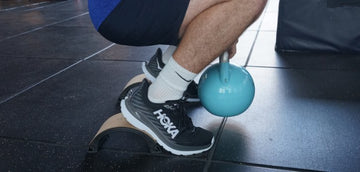
Ever seen someone at the gym squatting with their heels on weights and wondered why? It's more than just a new trend—it's a technique with surprising benefits. But, as with all things, there's a flip side. Dive into this article to uncover the awesome perks and the few pitfalls of this unique squat style.
Benefits of Squatting with Heels Elevated on Weights
- Improved Ankle Mobility: Limited ankle mobility can hinder the depth and form of a squat. Elevating the heels compensates for this limitation, reducing the need for extensive dorsiflexion. This adjustment allows individuals to achieve a deeper, more effective squat, especially if they've historically struggled with ankle flexibility.
- Targeting Quadriceps: When the heels are elevated, there's a noticeable shift in muscle emphasis towards the quadriceps. This positioning allows for a more direct engagement of the front thigh muscles, making it an excellent technique for those aiming to develop and strengthen their quads.
- Posture and Alignment: Maintaining an upright torso during squats can be challenging for some. Elevating the heels aids in achieving this upright position, reducing the forward lean that can strain the lower back. This alignment enhances the squat's effectiveness and minimizes potential back discomfort.
- Overcoming Biomechanical Limitations: Everyone's body structure is unique. Achieving a comfortable squat can be challenging for individuals with longer femurs relative to their tibia. Elevating the heels offers a biomechanical advantage, allowing for a more natural and comfortable squatting position tailored to one's anatomy.
- Transitioning to Flat Ground: Elevating the heels can be a stepping stone for those working on their squat technique. They can gradually transition to flat-ground squats as they improve in flexibility and form. It's a method that offers progression, ensuring continuous improvement without compromising form.
- Mimicking Weightlifting Shoes: Weightlifting shoes designed with elevated heels offer many squatting benefits. For those who don't have these specialized shoes, placing the heels on weights can replicate the effect, providing the advantages without the need for additional investment.
Drawbacks of Squatting with Heels Elevated on Weights
- Potential for Over-reliance: While elevating the heels can be beneficial, there's a risk of becoming overly reliant on this technique. Over time, this can prevent individuals from addressing and improving their inherent mobility issues, leading to long-term limitations in their squatting capabilities.
- Increased Knee Stress: Elevating the heels can place additional stress on the knees, especially if the weight is heavy. Over time, this added stress might lead to discomfort or potential injury, especially if proper form isn't maintained. Start with a much lighter weight that you would typically use to reduce knee stress.
- Stability Concerns: Using weights or unstable platforms to elevate the heels can sometimes lead to balance issues. If the weights shift or if there's any instability, there's a risk of injury from falling or from the weights themselves.
Case Study- My dad (no, really!)
Like any good son, I made my dad buy a Yoback when we launched on Kickstarter in November 2021. However, I didn't expect my dad would end up using it more than I do! My dad is 72 years old and has incredible dedication to basic fitness needs at his age. Every morning, he does simple but effective exercises; 20 press ups, 20 tricep dips, 1-minute plank and 1 minute as fast as possible on his exercise bike. Once he got the Yoback and I introduced him to the heel-raised squats, he also started doing 20 of these every morning.
He has said that his 'knees have never felt stronger' and that his golf game has improved due to increased muscle stamina, meaning he can easily walk the course without the tiredness he used to get.
Now, I know what you're thinking, is this guy using his dad as an example of why the Yoback is excellent for squats? Why should I believe his dad? Well, the answer is simple. You don't have to believe me (or my dad!), you can try it out for yourself. Get the Yoback today and try ten bodyweight squats every morning for 29 days. If on the 30th day, you feel no change at all, you can get your money back with our 30-day money-back guarantee and free returns policy!




























